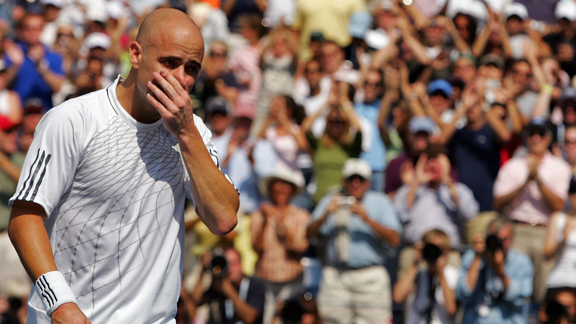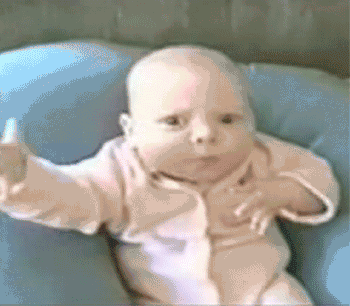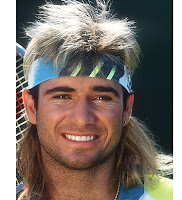Crystal meth, hair weaves and majors
Andre Agassi knows how low he once sunk because of the grand view he has now

Andre Agassi at his emotional farewell from tennis at the 2006 U.S. Open.
If image really is everything, why would Andre Agassi admit in his new book that he used crystal meth? Not once but dozens of times? And why would he admit he lied about it to the Association of Tennis Professionals?
Why would a son admit how much he feared his Iranian father -- feared him and hated him since the age of 7? And why -- why! -- would a man admit he wore perhaps the world's only Mohawk toupee?
Why? Because this isn't just any book.
This is Agassi's mea culpa -- "Open" (from Knopf, written with Pulitzer Prize winner J.R. Moehringer) -- and from the beginning, he and Moehringer set out to write the most revealing, literate and toes-stompingly honest sports autobiography in history. From the parts I've been allowed to read, they might have done it.
"I just tell people, this book is honest," says Agassi, who worked with Moehringer for a full year, meeting nearly daily at the Las Vegas house Agassi once lived in with Brooke Shields. "It lives up to the title. It's my life, for better or worse. Get ready, buckle up, and keep your arms and legs inside the vehicle at all times."
"Open" is the story of a flawed man who sees everybody's imperfections, but none more than his own. It's the tale of a man who knows how low he sunk if only because of the grand view he has now.
Agassi's early life was not his, never his, not from the beginning, not from the time his Olympic boxer father built a backyard prison especially for him, a tennis court he was figuratively chained to day after day, while his father's homemade ball machine -- the dragon, Agassi called it -- ceaselessly spit out balls faster, harder, forever.
Agassi bucked against tennis like a horse with a two-sizes-too-small bit. But he could not escape it. And so his life became a kind of lie, from his shoelace groundstrokes to his Mohawk, a hairpiece that once came apart in the shower before the French Open. The day was saved by bobby pins.
Your own life is hard enough. Living somebody else's life for them weighs on a man like a stone backpack. By 1997 -- even after winning an Olympic gold medal in 1996 -- Agassi was down, depressed and stuck playing a game he didn't love. He was physically wrecked (wrist) and emotionally spent. He was with the wrong woman -- Shields -- and knew it.
He'd sunk to No. 141 in the world. He recalls that he was sitting at home when his assistant, Slim, introduced him to one of the most addictive substances known to man:
Slim says, You want to get high with me?
On what?
Gack.
What the hell's gack?
Crystal meth.
Why do they call it gack?
Because that's the sound you make when you're high. Make you feel like Superman, dude.
As if they're coming out of someone else's mouth, I hear these words: You know what? F*** it. Yeah. Let's get high.
Agassi pulled himself out of the French Open that year and hardly practiced for Wimbledon. That fall, it got worse. The ATP informed him at the end of 1997 that he'd flunked a drug test. He would likely be looking at a three-month suspension. He would probably lose all his endorsements and most of his fans.
What to do? Keep lying.
Agassi admits he wrote a letter to the ATP saying Slim accidentally "spiked" his drink, that it was not his fault. The ATP dropped the flunked test, with no discipline for Agassi. He admits in the book he felt "ashamed."
It was the lowest point in a life that would suddenly begin to soar. You can condemn Agassi all you want for the crystal meth -- and he'd deserve it -- but remember, Agassi dropped the habit soon after. Then, in 1998, he made the biggest one-year jump into the Top 10 in the history of the ATP Rankings, going from his year-end 122 to No. 6. He'd win five of his eight major titles after finding the bottom.
They call Agassi the greatest returner in history. They aren't kidding.
We all know what became of the showy, glitzy kid with all that fake hair and real talent. He shaved his hair off. He started being real. He learned to love tennis, and tennis learned to love him. The kid who never got past the ninth grade in school wound up funding and running the prestigious Andre Agassi College Preparatory Academy in Las Vegas. The man who couldn't find the right woman finally married the one everybody wanted -- tennis goddess Steffi Graf. And the son who hated his father learned to love him and his own two kids.
Why is Agassi so scorchingly honest in these excerpts? Maybe because he once lived enough lies for five men. Or maybe because, as an educator, he's heard the truth can set him free.
But hopefully, by the time you close "Open," you'll know that this book is about more than the wrong turns he took. It's about how that broken road led him straight to the good man he is now.
Andre Agassi knows how low he once sunk because of the grand view he has now

Andre Agassi at his emotional farewell from tennis at the 2006 U.S. Open.
If image really is everything, why would Andre Agassi admit in his new book that he used crystal meth? Not once but dozens of times? And why would he admit he lied about it to the Association of Tennis Professionals?
Why would a son admit how much he feared his Iranian father -- feared him and hated him since the age of 7? And why -- why! -- would a man admit he wore perhaps the world's only Mohawk toupee?
Why? Because this isn't just any book.
This is Agassi's mea culpa -- "Open" (from Knopf, written with Pulitzer Prize winner J.R. Moehringer) -- and from the beginning, he and Moehringer set out to write the most revealing, literate and toes-stompingly honest sports autobiography in history. From the parts I've been allowed to read, they might have done it.
"I just tell people, this book is honest," says Agassi, who worked with Moehringer for a full year, meeting nearly daily at the Las Vegas house Agassi once lived in with Brooke Shields. "It lives up to the title. It's my life, for better or worse. Get ready, buckle up, and keep your arms and legs inside the vehicle at all times."
"Open" is the story of a flawed man who sees everybody's imperfections, but none more than his own. It's the tale of a man who knows how low he sunk if only because of the grand view he has now.
Agassi's early life was not his, never his, not from the beginning, not from the time his Olympic boxer father built a backyard prison especially for him, a tennis court he was figuratively chained to day after day, while his father's homemade ball machine -- the dragon, Agassi called it -- ceaselessly spit out balls faster, harder, forever.
Agassi bucked against tennis like a horse with a two-sizes-too-small bit. But he could not escape it. And so his life became a kind of lie, from his shoelace groundstrokes to his Mohawk, a hairpiece that once came apart in the shower before the French Open. The day was saved by bobby pins.
Your own life is hard enough. Living somebody else's life for them weighs on a man like a stone backpack. By 1997 -- even after winning an Olympic gold medal in 1996 -- Agassi was down, depressed and stuck playing a game he didn't love. He was physically wrecked (wrist) and emotionally spent. He was with the wrong woman -- Shields -- and knew it.
He'd sunk to No. 141 in the world. He recalls that he was sitting at home when his assistant, Slim, introduced him to one of the most addictive substances known to man:
Slim says, You want to get high with me?
On what?
Gack.
What the hell's gack?
Crystal meth.
Why do they call it gack?
Because that's the sound you make when you're high. Make you feel like Superman, dude.
As if they're coming out of someone else's mouth, I hear these words: You know what? F*** it. Yeah. Let's get high.
Agassi pulled himself out of the French Open that year and hardly practiced for Wimbledon. That fall, it got worse. The ATP informed him at the end of 1997 that he'd flunked a drug test. He would likely be looking at a three-month suspension. He would probably lose all his endorsements and most of his fans.
What to do? Keep lying.
Agassi admits he wrote a letter to the ATP saying Slim accidentally "spiked" his drink, that it was not his fault. The ATP dropped the flunked test, with no discipline for Agassi. He admits in the book he felt "ashamed."
It was the lowest point in a life that would suddenly begin to soar. You can condemn Agassi all you want for the crystal meth -- and he'd deserve it -- but remember, Agassi dropped the habit soon after. Then, in 1998, he made the biggest one-year jump into the Top 10 in the history of the ATP Rankings, going from his year-end 122 to No. 6. He'd win five of his eight major titles after finding the bottom.
They call Agassi the greatest returner in history. They aren't kidding.
We all know what became of the showy, glitzy kid with all that fake hair and real talent. He shaved his hair off. He started being real. He learned to love tennis, and tennis learned to love him. The kid who never got past the ninth grade in school wound up funding and running the prestigious Andre Agassi College Preparatory Academy in Las Vegas. The man who couldn't find the right woman finally married the one everybody wanted -- tennis goddess Steffi Graf. And the son who hated his father learned to love him and his own two kids.
Why is Agassi so scorchingly honest in these excerpts? Maybe because he once lived enough lies for five men. Or maybe because, as an educator, he's heard the truth can set him free.
But hopefully, by the time you close "Open," you'll know that this book is about more than the wrong turns he took. It's about how that broken road led him straight to the good man he is now.







 jk
jk
 jk again NOT..!! i mean common couldnt get past 9th grade..!!
jk again NOT..!! i mean common couldnt get past 9th grade..!!



Comment